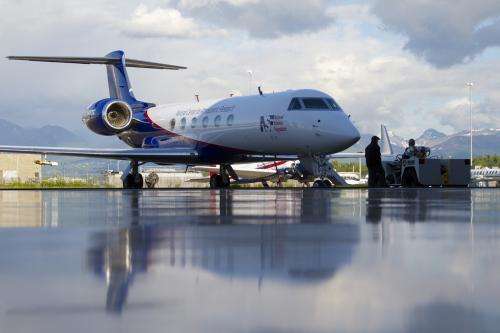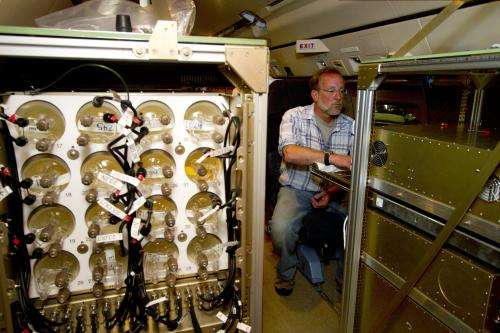Seasonal carbon dioxide range expanding as more is added to Earth's atmosphere

Levels of carbon dioxide in the atmosphere rise and fall each year as plants, through photosynthesis and respiration, take up the gas in spring and summer, and release it in fall and winter.
Now the range of that cycle is expanding as more carbon dioxide is emitted from burning fossil fuels and other human activities, according to a study led by scientists at the Scripps Institution of Oceanography (SIO).
The findings come from a multi-year airborne survey of atmospheric chemistry called HIAPER Pole-to-Pole Observations, or HIPPO.
Results of the study are reported in a paper published online this week by the journal Science.
The National Science Foundation (NSF), along with the U.S. Department of Energy, the National Center for Atmospheric Research (NCAR), the National Oceanic and Atmospheric Administration (NOAA) and the Office of Naval Research funded the study.
"This research provides dramatic evidence of the significant influence the land-based biosphere can have on the amplitude [amount of change] in seasonal trends of carbon dioxide exchange," says Sylvia Edgerton, program director in NSF's Division of Atmospheric and Geospace Sciences, which funded the research.
Observations of atmospheric carbon dioxide made by aircraft at altitudes between 3 and 6 kilometers (10,000-20,000 feet) show that seasonal carbon dioxide variations have substantially changed during the last 50 years.
The amplitude increased by roughly 50 percent across high latitude regions north of 45° N, compared with previous aircraft observations from the late 1950s and early 1960s.
This means that more carbon is accumulating in forests and other vegetation and soils in the Northern Hemisphere during the summer, and more carbon is being released in the fall and winter, says study lead scientist Heather Graven of SIO.
It's not yet understood, she says, why the increase in seasonal amplitude of carbon dioxide concentration is so large, but it's a clear signal of widespread changes in northern ecosystems.
"The atmospheric carbon dioxide observations are important because they show the combined effect of ecological changes over large regions," says Graven.
"This reinforces ground-based studies that show that substantial changes are occurring as a result of rising carbon dioxide concentrations, warming temperatures and changing land management, including the expansion of forests in some regions and the poleward migration of ecosystems."
Adds Peter Milne, a program director in NSF's Division of Atmospheric and Geospace Sciences, "We can easily measure the greenhouse gas budget from a single smokestack, but somewhat less well for a stand of trees. Knowing that for the entire planet is much more challenging.
"Taking advantage of the long-duration and high-altitude-profiling capabilities of the NSF Gulfstream V aircraft [also known as HIAPER], the HIPPO project was designed to take a 'snapshot' of the global troposphere [Earth's lowest atmospheric layer] to see whether we can explain and model greenhouse gas distribution."

In the study, the scientists compared the recent aircraft data with aircraft data gathered from 1958 to 1961 using U.S. Air Force weather reconnaissance flights.
The older data were analyzed by SIO geochemist Charles David Keeling, the father of Ralph Keeling, also an SIO scientist and a member of the research team.
These aircraft measurements were done at the time Charles Keeling was beginning continuous carbon dioxide measurements at Mauna Loa, Hawaii.
While the Mauna Loa measurements are now widely recognized as the "Keeling Curve," the early aircraft data were all-but-forgotten.
Carbon dioxide concentrations in the atmosphere have varied between 170 and 280 parts per million during the last 800,000 years.
When Charles Keeling began collecting data at Mauna Loa in 1958, the concentration had risen to about 315 parts per million.
In May, 2013, daily carbon dioxide measurements at Mauna Loa exceeded 400 parts per million—for the first time in human history.
Recent observations aboard the Gulfstream V were made during regular flights conducted during the HIPPO campaign, from 2009 to 2011.
The aircraft repeatedly ascended and descended from a few hundred meters to roughly 12 kilometers (40,000 feet) in the skies between the North Pole and Antarctica. The goal was constructing a unique snapshot of the chemical composition of the atmosphere.
Additional recent data comes from regular flights conducted by NOAA at a network of locations.
Increasing carbon dioxide amplitude since 1960 had already been observed at two ground-based stations: Mauna Loa and Barrow, Alaska.
Other stations operated by Scripps and NOAA only began measuring carbon dioxide in the 1970s to 1990s.
The aircraft-based observations uniquely show the large area in northern high latitudes where carbon dioxide amplitude increased strongly since 1960.
The exact reasons for the wider seasonal swings in carbon dioxide concentration remain to be determined, say the researchers.
Although plant activity can increase with warmer temperatures and higher carbon dioxide concentrations, the change in carbon dioxide amplitude over the last 50 years is larger than expected from these effects.
Carbon dioxide concentration has increased by 23 percent, and average temperature north of 30°N has increased by one degree C, since 1960.
Other factors may be changes in the amount of carbon in leaves, wood or roots; changes in the extent or species composition of ecosystems; or changes in the timing of plant photosynthesis and respiration.
Simulating complex processes in land-based ecosystems with models is a challenge, scientists have found.
The observed change in carbon dioxide amplitude is larger than that simulated by models used by the Intergovernmental Panel on Climate Change (IPCC).
While this underestimate does not call into question the response of climate to carbon dioxide concentration in the IPCC models, the researchers say, it does suggest that a better understanding of what happened during the last 50 years could improve projections of future ecosystem changes.
The bottom line, according to Graven, Ralph Keeling and colleagues, is that Northern ecosystems appear to be behaving differently than they did 50 years ago.
More information: "Enhanced Seasonal Exchange of CO2 by Northern Ecosystems Since 1960," by H.D. Graven et al. Science, 2013.
Journal information: Science
Provided by National Science Foundation















